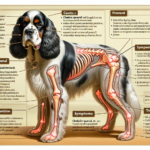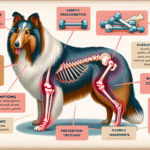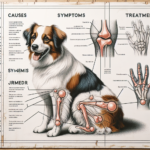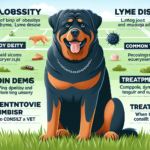Clumber Spaniel Joint Pain: Causes, Symptoms, Prevention, and Treatment

Introduction
The Clumber Spaniel is a distinguished breed known for its gentle demeanor, intelligence, and robust build. Originating from England, this breed was developed in the 18th century and named after Clumber Park in Nottinghamshire. Clumber Spaniels were initially bred for hunting, particularly for retrieving game in dense underbrush, thanks to their strong sense of smell and sturdy physique. They are characterized by their large heads, deep chests, and dense, straight coats, typically white with lemon or orange markings.
While Clumber Spaniels are generally healthy dogs, they are prone to certain health issues, including joint pain. Joint health is particularly crucial for this breed due to their size and weight, which can put additional stress on their joints. Understanding the causes, symptoms, prevention, and treatment of joint pain in Clumber Spaniels is essential for ensuring their well-being and maintaining their quality of life.
Breed-Specific Joint Pain Risks
Genetic Predisposition
Clumber Spaniels have a genetic predisposition to several joint-related issues, including hip dysplasia, elbow dysplasia, and arthritis. Hip dysplasia is a condition where the hip joint does not fit properly into the hip socket, leading to pain and mobility issues. Elbow dysplasia involves abnormal development of the elbow joint, causing lameness and discomfort. Arthritis, a degenerative joint disease, is also common in Clumber Spaniels, particularly as they age.
Age-Related Risks
As Clumber Spaniels age, the risk of developing joint pain increases. Typically, signs of joint issues may start to appear when the dog reaches middle age, around 5 to 7 years old. However, some dogs may show symptoms earlier, especially if they have a genetic predisposition or have experienced joint injuries. Regular veterinary check-ups are crucial for early detection and management of age-related joint problems.
Activity Level and Joint Stress
Clumber Spaniels are moderately active dogs that enjoy regular exercise. However, their heavy build can put extra stress on their joints, especially if they engage in high-impact activities like jumping or running on hard surfaces. While exercise is essential for their overall health, it is important to balance activity levels to prevent joint strain and injuries.
Common Symptoms of Joint Pain in Clumber Spaniels
General Symptoms
- Limping or favoring one leg
- Stiffness, especially after rest or exercise
- Reluctance to move, jump, or climb stairs
- Decreased activity or playfulness
- Swelling around the joints
- Whining or showing signs of discomfort when touched
Breed-Specific Symptoms
In Clumber Spaniels, joint pain may manifest as a noticeable change in their gait, often described as a “bunny hop” when running. They may also show a reluctance to engage in activities they previously enjoyed, such as retrieving or playing fetch. Due to their stoic nature, Clumber Spaniels might not always vocalize their pain, making it essential for owners to observe subtle changes in behavior and movement.
When to Consult a Vet
If you notice any signs of joint pain in your Clumber Spaniel, it is important to consult a veterinarian promptly. Early intervention can help manage the condition and prevent further deterioration. Seek veterinary advice if your dog shows persistent limping, stiffness, or reluctance to move, as these could indicate underlying joint issues that require professional attention.
Preventive Measures for Joint Health
Exercise Recommendations
Regular, low-impact exercise is crucial for maintaining joint health in Clumber Spaniels. Activities such as walking, swimming, and gentle play are ideal for keeping their joints flexible and muscles strong without causing excessive strain. Avoid high-impact activities like jumping or running on hard surfaces, as these can exacerbate joint issues. Aim for consistent, moderate exercise rather than sporadic, intense sessions.
Dietary Suggestions
A balanced diet rich in essential nutrients can support joint health in Clumber Spaniels. Consider incorporating foods or supplements that contain glucosamine, chondroitin, and omega-3 fatty acids, which are known to promote joint health and reduce inflammation. Consult your veterinarian for specific dietary recommendations and appropriate supplements for your dog.
Weight Management
Maintaining a healthy weight is critical for reducing joint stress in Clumber Spaniels. Excess weight can exacerbate joint pain and lead to further complications. Monitor your dog’s weight regularly and adjust their diet and exercise routine as needed to keep them within a healthy weight range. Your veterinarian can provide guidance on the ideal weight for your Clumber Spaniel and help develop a weight management plan if necessary.
Early Screening and Monitoring
Regular veterinary check-ups and early screening for joint issues can help detect problems before they become severe. Consider breed-specific screening tests, such as hip and elbow evaluations, to identify any predispositions to joint conditions. Early detection allows for timely intervention and management, improving your dog’s quality of life.
Treatment Options for Joint Pain
Non-Surgical Treatments
Non-surgical treatments for joint pain in Clumber Spaniels include medications, physical therapy, and lifestyle adjustments. Anti-inflammatory medications and pain relievers can help manage pain and reduce inflammation. Physical therapy, including exercises and massage, can improve joint mobility and strengthen supporting muscles. Lifestyle adjustments, such as providing a comfortable bed and avoiding high-impact activities, can also alleviate joint pain.
Surgical Options
In severe cases of joint pain, surgical intervention may be necessary. Common surgical options for Clumber Spaniels include hip replacement, arthroscopy, and joint fusion. Hip replacement involves replacing the damaged hip joint with an artificial one, while arthroscopy is a minimally invasive procedure to remove or repair damaged joint tissue. Joint fusion, or arthrodesis, involves fusing the bones of a joint to eliminate pain. Consult your veterinarian to determine the most appropriate surgical option for your dog.
Alternative Therapies
Alternative therapies such as acupuncture, hydrotherapy, and massage can provide additional relief for joint pain in Clumber Spaniels. Acupuncture involves inserting thin needles into specific points on the body to stimulate healing and reduce pain. Hydrotherapy, or water therapy, allows dogs to exercise in a low-impact environment, reducing joint stress. Massage can improve circulation, reduce muscle tension, and promote relaxation. These therapies can be used in conjunction with traditional treatments to enhance overall well-being.
Lifestyle and Management Tips
Daily Care Routine
A consistent daily care routine can help manage and alleviate joint pain in Clumber Spaniels. Start with a gentle morning walk to loosen stiff joints, followed by a balanced meal with joint-supporting supplements. Incorporate low-impact playtime and regular rest periods throughout the day. In the evening, provide a comfortable bed and consider a gentle massage to relax muscles and joints.
Modifying the Home Environment
Making your home more comfortable for a dog with joint pain can significantly improve their quality of life. Consider installing ramps to help them navigate stairs and providing orthopedic beds to support their joints while resting. Ensure that food and water bowls are at an appropriate height to reduce strain on their neck and joints. Creating a safe and accessible environment can help your Clumber Spaniel move comfortably and reduce the risk of further injury.
Long-Term Management
Long-term management of joint pain in Clumber Spaniels involves regular veterinary check-ups, consistent exercise, a balanced diet, and appropriate weight management. Monitor your dog’s condition closely and adjust their care routine as needed to address any changes in their joint health. By taking proactive measures and providing ongoing support, you can help your Clumber Spaniel lead a happy and active life despite joint pain.
FAQs About Clumber Spaniels and Joint Pain
What are the early signs of joint pain in Clumber Spaniels?
Early signs of joint pain in Clumber Spaniels include limping, stiffness, reluctance to move, and decreased activity levels. You may also notice swelling around the joints and changes in behavior, such as increased irritability or reluctance to be touched.
Can joint pain in Clumber Spaniels be prevented?
While it may not be possible to completely prevent joint pain in Clumber Spaniels, taking preventive measures can significantly reduce the risk. Regular exercise, a balanced diet, weight management, and early screening for joint issues can help maintain joint health and prevent severe problems.
Are there specific exercises that are better for Clumber Spaniels with joint pain?
Low-impact exercises such as walking, swimming, and gentle play are ideal for Clumber Spaniels with joint pain. These activities help maintain joint flexibility and muscle strength without causing excessive strain. Avoid high-impact activities like jumping or running on hard surfaces.
What dietary supplements can support joint health in Clumber Spaniels?
Dietary supplements that support joint health in Clumber Spaniels include glucosamine, chondroitin, and omega-3 fatty acids. These nutrients help promote joint health, reduce inflammation, and alleviate pain. Consult your veterinarian for specific supplement recommendations and dosages.
When should I consider surgical options for my Clumber Spaniel’s joint pain?
Surgical options should be considered when non-surgical treatments are no longer effective in managing your Clumber Spaniel’s joint pain. Severe cases of hip dysplasia, elbow dysplasia, or advanced arthritis may require surgical intervention. Consult your veterinarian to determine the most appropriate course of action for your dog.
Conclusion
Joint pain is a common concern for Clumber Spaniels, but with proper care and attention, it can be managed effectively. Understanding the causes, symptoms, prevention, and treatment options is essential for maintaining your dog’s joint health and overall well-being. By taking proactive measures, such as regular exercise, a balanced diet, weight management, and early screening, you can help prevent joint issues and ensure your Clumber Spaniel leads a happy and active life. Always consult your veterinarian for personalized advice and treatment options to address your dog’s specific needs.




